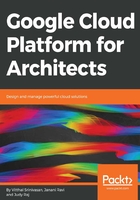
Setting up a GCP account
Execute the following steps to set up a GCP account:
- Go to https://console.developers.google.com/ and sign in to continue using Google Cloud Platform.
- If you already have a Gmail account that's what you will use to sign in here. If you don't, get a Gmail account before you sign in to Google Cloud Platform.
- If you are doing this for the very first time, it will take you to a page where it will ask you for a bunch of personal information.
This is where you get access to all GCP products. Google currently enables a free trial for everyone and gives you 300 US Dollars of free credit. So even if you are going to upgrade to a paid account, you won't shell out any money until you reach the 300 dollar limit. In addition, if you consume resources worth more than 300 USD, all your resources will be shut down, so you don't inadvertently end up paying a large bill because you forgot to turn down VM or shut down a BigTable instance. Google is considerate that way. You will need to provide a credit card number in order to use the free trial, but you won't be charged though.
Your Google Cloud account has been created. You will automatically be taken to a page that is the dashboard for your account:

The first thing is to create a new project. Click on the drop-down icon right up top next to the three horizontal lines (that is, the Products & Services menu, also colloquially known as the hamburger). Here, we already have a project; the name of that project is loonycorn-project08:

If you click on the arrow next to the project name, a new dialog will open up, allowing you to create a new project, or select an existing one:

The projects associated with your Google Cloud Account are your top level billing instances. All of the GCP resources are provisioned under some or another project. You can choose between having a common billing account for each project or separate ones accordingly. All projects and billing accounts can be linked to a common organization, which will be linked to your Google Cloud account. Billing accounts encompass source of payment (for example, credit card details). Thus via different billing accounts you can ask different people to pay for different resources (for example, different teams of your organization).
Every project has a unique name which you specify as well as an ID generated by Google. The project ID contains the project name which we have specified and a string of numbers which makes it unique across GCP globally.
Let's orient ourselves on the dashboard page. At the very top, you can see what project this dashboard is associated with. There is also a dropdown to allow you to switch between projects easily. The very first card gives us the details of the projects such as its name and the associated project ID. There is also a quick link to your project settings page where you can change your billing information and other project-related details. The compute engine card shows you a summary of your compute instances. We have no instances; therefore, this card is currently empty. We get a quick status check on the right indicating that all our services are green. We can see the billing details of the project at a glance.
Now we are at the Google Cloud dashboard that shows how we get all the services that Cloud Platform makes available to us. You will use this three-line navigation button at the top left. This is the most important button that you will find that while reading this book and using the platform:

You will be navigating here over and over again. Click on the hamburger menu, open up the navigation menu, and you will see all Cloud Platform services and products available to you. Take the time and explore this menu as there is a lot of interesting stuff out there. But what are we going to work on? First is to create a VM instance, an instance of the compute engine. Go to the compute engine menu and click on VM instances:

This will take us to a page where we can create our very first virtual machine instance on Google Cloud. You also now know that all Google Cloud resources or services or products that you use are built to a top-level projects. You can set up different projects for different teams in your organization.